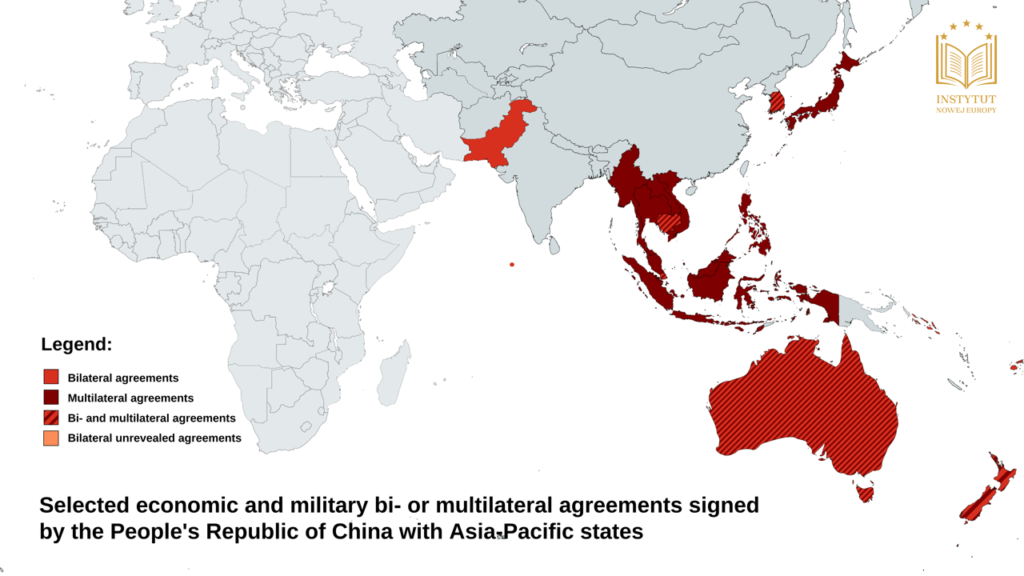The authors: Kamil Opara, Jakub Iwan, Łukasz Kobierski
The aim of the maps is to illustrate the network of cooperation platforms as well as economic and military dependencies installed in the Asia-Pacific Region by the US and China across the last few decades (until 31st July 2022).
The Asia-Pacific region (further denoted as AP Region) broadly speaking encompasses the countries located in the f area of the Pacific Ocean (East Asia, Russian Far East, Australia, and Oceania). The strategic importance of the region stems from several factors. It is traversed by crucial international trade routes (both maritime and ground); it is also abundant with energy resources located in different parts of the Ocean (primarily in the South China Sea). Moreover, it is also characterized by the abundance rich resources of living resources and significant maritime biodiversity. Last but not least, it comprises the countries of huge significance on the international stage (vide e.g. China, India, Australia, etc.).
In the AP Region (part of the Indo-Pacific region), the two world biggest superpowers (the United States and the Chinese People’s Republic) locate their vested interests. The rivalry between these two superpowers has grown more significant in the last few years, manifesting itself also in this region. Washington and Beijing embrace a variety of tools to enlarge and solidify their spheres of influence in the area, e.g. by striking multiple economic (trade facilitations, economic cooperation) and military (security, defensive commitments, shared drills) deals.
Below, we present two maps that display some of the AP countries associated with the US and China via different economic and military deals. Every accord is specified and shortly described. The map does not include the Russian Federation. It encompasses though some of the deals whose provisions (or, in some cases, even the fact of its conclusion) are not made public due to their potential importance (e.g. CPR-Samoa, CPR-Solomon Islands, US-Solomon Islands). The analysis also features some remarks regarding the QUAD as an informal alliance. Despite the lack of an official agreement between the countries, QUAD is developing so considerably, that the authors recognized the need to consider also this group of countries.
The map no.1 The U.S. and Asian&Pacific region agreements
The map no. 2 China and Asian&Pacific region agreements
The maps aim to illustrate the network of cooperation platforms as well as economic and military dependencies built in the Asia-Pacific Region by Washington and Beijing over the last few decades (until 31st July 2022). The maps do not contain all of the agreements, only the most relevant to the issue of the analysis according to the authors of the following report (the full list can be found below the “Conclusions” section).
Conclusions:
- The American system of alliances and associations in the AP Region is more advanced than the Chinese one. The number of military (security and defence) and economic deals struck by Washington is bigger than in the case of Beijing. It signifies that military cooperation with the US is seen as an attractive option by many countries in the region.
- Many AP countries develop collaboration both with the US and China (e.g. South Korea, Thailand, Malaysia, and Australia). It often results from the economic calculations and will to reap the financial benefits thanks to the deals struck with both sides. Whereby, indicated countries tend to reach both military and economic agreements only with one side, the other country is left only with the economic agreement (vide Japan). It is probably a result of the high sensitivity and strategic importance of the military sphere and related protection of data and information.
- United States is more determined to establish military bonds with the AP countries (to put up a kind of protective umbrella upon the allies) – this conclusion bases on the observation that Washington is entering more agreements that pertain to military issues than the economy. At the same time, China is focused primarily on building and strengthening economic ties with the AP countries. That state of affairs might also be rendered by some non-strategic, objective factors, such as the geographical vicinity of CPR. It certainly implies the necessity of upholding and strengthening the economic cooperation with China (it also results from strong economic connections between AP and China).
- Some states orient themselves unequivocally on cooperation with only one country (either the US or CPR). It is usually an implication of political calculations and the following foreign policy which is often related to common values and regulations. India can serve as an example – as a democratic country, they hold military agreements only with the United States. In the economic field, they are also more inclined to cooperate with the States – that is partly conditioned by the regional rivalry between India and China. Sri Lanka, which makes up an interesting example, to a large extent replicates the main directions of India’s foreign policy.
- Over the recent few years, China has managed to establish a strong network of dependencies – particularly economic – with the ASEAN countries. All states grouped in the ASEAN are sides of either bilateral, or multilateral deals with CPR. Furthermore, ASEAN as an organization has signed a separate agreement with Beijing.
- The United States institutionalize (through entering a number of deals) the cooperation both with the democratic and Western-thinking countries (vide Australia, New Zealand, to some extent also India) and with the countries of typically Asian specificity, with completely different legal cultures and political systems.
- Establishing and cherishing the collaboration in the economic (trade in particular) and military (military-defensive) fields makes up a tool of the regional rivalry between the CPR and the US.
- The systems of bilateral and multilateral deals that the US and China hold with the AP countries provide only a partial explanation of the intricacies of interstate relations in the region. They serve as a useful tool to conceptualize the extent of respective spheres of military and economic influence, constructed by both superpowers in the region. Identifying the actual regional networks of collaboration and military/economic dependencies deserves further observation, intensified analytical effort, and deepened consideration of the qualitative criteria.
Military agreements (security, trainings, maneuvers, defence commitments) between the US and AP countries:
- Japan – Treaty of Mutual Cooperation and Security between the United States and Japan from 1960. It is a bilateral agreement that establishes a military alliance between the two countries, American defence commitments to Japan, and keeping American military bases on Japanese territory.
- Thailand – Thanat–Rusk Communiqué from 1962. It is a bilateral agreement encompassing the military alliance of both countries and American defence commitments to Thailand.
- Philippines – Mutual Defense Treaty between the Republic of the Philippines and the United States of America from 1951. It is a bilateral agreement establishing a military alliance of both countries and indicating a commitment of both parties to collective action when one of them has been attacked by another country.
- South Korea – Mutual Defense Treaty between the United States and the Republic of Korea from 1953. This bilateral deal has been a bedrock for a long-lasting military alliance between both countries – Americans are obligated to protect Korea, and their army is permitted to remain on the Korean territory.
- New Zealand and Australia – ANZUS (Australia, New Zealand, United States Security Treaty) from 1951. It is a multilateral treaty establishing a military alliance of the three countries and collective support in case of external assault on the US, New Zealand, or Australia.
- Australia – AUKUS (Australia, United Kingdom, United States) from 2021. It is a multilateral treaty that assumes American-British cooperation in building nuclear-powered submarines for the Australian Navy and joint efforts in military industry, i.a. focused on advanced military technologies.
- India – bilateral Communications Compatibility and Security Agreement from 2018 encompassing the exchange of information about the military maneuvers and hardware used in them. Besides, it also establishes cooperation in the 2+2 format (Indian and American foreign affairs and defence ministries).
- India – Logistics Exchange Memorandum of Agreement from 2016. It is a bilateral treaty that allows each side to use the other side’s bases to fuel and service the military hardware.
- Brunei – bilateral Memorandum of Understanding from 1994 encompassing joint military drills and organizing shared training programs.
- Bangladesh, Brunei, Cambodia, Indonesia, Malaysia, Philippines, Singapore, Sri Lanka, Thailand – Cooperation Afloat Readiness and Training. It is a multilateral deal extended successively by other members since 1995. It serves as a framework for organizing joint military drills of the US Navy and respective navies of member-states.
- Singapore – Memorandum of Understanding Regarding United States Use of Facilities in Singapore from 1990, extended in 2019. On the basis of this bilateral agreement, American jet fighters and military vessels are allowed to station on the Singaporean territory until 2035.
- Singapore – bilateral U.S.–Singapore Strategic Framework Agreement from 2005 allowing the American military vessels to station in the Singaporean Navy base in Changi.
- Philippines – bilateral Enhanced Defense Cooperation Agreement from 2014 aimed at organizing the military cooperation between the parties and validating American Army deployed in the Philippines.
- Solomon Islands – according to the information available from the US Department of State, the US cooperates with the Solomon Islands (mainly with the police forces) in the fields of military drills, training, border protection, etc. The specific text of the agreement has not been unveiled.
- Bangladesh, Cambodia, Indonesia, Malaysia, Mongolia, Nepal, Papua New Guinea, Philippines, Sri Lanka, Maldives, Thailand, East Timor, Tonga, Fiji, and Vietnam – multilateral agreement successively entered by the respective countries since 2000. It assumes conducting joint training organized by the US National Guard for local law enforcement units.
- Australia, India, and Japan – non-structured (non-based on the official document) multilateral cooperation format QUAD (Quadrilateral Security Dialogue)[1] initiated in 2007 and reinvigorated in 2017. It assumes joint military drills, enhancing the defensive potentials of member-states, developing economic partnerships, and critical branches of industry, establishing new supply chains, cooperation in the field of cybersecurity, climate protection, and countering the effects of natural disasters.
Economic agreements between the US and AP countries:
- Australia – Australia-United States Free Trade Agreement from 2004. It is a bilateral deal aimed at the facilitation and development of economic cooperation.
- South Korea – bilateral United States-Korea Free Trade Agreement from 2007, aimed at facilitation and development of economic cooperation.
Military agreements (security, trainings, maneuvers, defence commitments) between the CPR and AP countries:
- Solomon Islands – bilateral China-Solomon Islands Security Pact from 2022 which content and provisions are partly undisclosed to the general public. According to the media reports, the deal might concern the presence of the Chinese law enforcement officers, troops, and Navy vessels in Honiara on Guadalcanal island. It is alleged also to allow the Chinese Navy to replenish the supplies and service the vessels on Solomon Island’s territory.
- Fiji – Memorandum of Understanding from 2011. Based on this agreement, CPR will assist Fijian authorities in providing training for police officers in the areas like rescue operations, countering terrorism, preventing money laundering, and countering human trafficking and cybercrime.
- Cambodia – Memorandum of Understanding from 2022. Based on that agreement, both sides will combine efforts to improve cooperation in terms of strategic communication, joint military maneuvers, and training, as well as the exchange of personnel. Moreover, Chinese police officers will be based in Cambodia and tasked with countering the crime in South-East Asia. Unofficially the agreement allows the Chinese navy to deploy their vessels to the Navy base in Ream (Cambodia).
- Samoa – bilateral agreement from 2022 whose provisions are yet to be published. The leaks indicate that this agreement is in some areas similar to the one reached with the Solomon Islands and concerns i.a. providing training for the Samoan police officers by the CPR, cybersecurity cooperation, and broader access of the Chinses to the natural resources in Samoa.
Economic agreements between the CPR and AP countries:
- Australia, Brunei, Cambodia, Indonesia, Japan, South Korea, Laos, Malaysia, Burma, New Zealand, Philippines, Singapore, Thailand, and Vietnam – multilateral agreement Regional Comprehensive Economic Partnership from 2020 (implemented in 2022). It envisions the liquidation of more than 90% of customs tariffs during the next 20 years and significant facilitation in trade between signatory states. Besides, it announces elaborating the common legal framework for e-commerce and the protection of intellectual property.
- Cambodia – bilateral China-Cambodia Free Trade Agreement from 2020 (facilitations in trade between the countries, i.a lifting tariffs).
- Maldives – bilateral China-Maldives Free Trade Agreement from 2017 (as above).
- Australia – bilateral China-Australia Free Trade Agreement from 2015 (as above).
- South Korea – bilateral China-ROK Free Trade Agreement from 2014 (as above).
- Singapore – bilateral China-Singapore Free Trade Agreement from 2008 (as above).
- New Zealand – bilateral China-New Zealand Free Trade Agreement from 2008 (as above).
- Pakistan – bilateral China-Pakistan Free Trade Agreement from 2009 (as above).
- ASEAN countries (Vietnam, Malaysia, Philippines, Indonesia, Thailand, Burma, Singapore, Laos, Cambodia, Brunei) – multilateral agreement China-ASEAN Free Trade Area. It has been gradually implemented since 2002 and provides facilitations in economic cooperation and trade.
Translation: Marcin Pijaj
[1] Quad was initiated primarily as a military cooperation format. Over the recent few years, the tendency to extend the QUAD agenda to economic security issues has been spotted. In fact, QUAD should be considered as the format of both military and economic cooperation.



































Comments are closed.